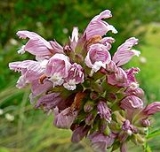
Cedronella
Encyclopedia
Cedronella is a genus
of flowering plant
s in the Mentheae tribe of family Lamiaceae
, comprising a single species, Cedronella canariensis, endemic
to the Canary Islands
. Common names include Canary Islands-balm, Canary balm, and Balm-of-Gilead.
It is a perennial
herbaceous
plant growing to 1-1.5 m tall. The distinctive feature of these plants is the compound leaves consisting of 3 leaflets, unusual in the Lamiaceae, which usually have simple leaves. The leafy stems terminate in dense, short spikes of flowers with tubular 2-lipped white or pink flower
s.
The genus name is a diminutive of Cedrus, though the only connection between this herb
and the large conifers of Cedrus is a vaguely similar resin
ous scent of the foliage.
Genus
In biology, a genus is a low-level taxonomic rank used in the biological classification of living and fossil organisms, which is an example of definition by genus and differentia...
of flowering plant
Flowering plant
The flowering plants , also known as Angiospermae or Magnoliophyta, are the most diverse group of land plants. Angiosperms are seed-producing plants like the gymnosperms and can be distinguished from the gymnosperms by a series of synapomorphies...
s in the Mentheae tribe of family Lamiaceae
Lamiaceae
The mints, taxonomically known as Lamiaceae or Labiatae, are a family of flowering plants. They have traditionally been considered closely related to Verbenaceae, but in the 1990s, phylogenetic studies suggested that many genera classified in Verbenaceae belong instead in Lamiaceae...
, comprising a single species, Cedronella canariensis, endemic
Endemic (ecology)
Endemism is the ecological state of being unique to a defined geographic location, such as an island, nation or other defined zone, or habitat type; organisms that are indigenous to a place are not endemic to it if they are also found elsewhere. For example, all species of lemur are endemic to the...
to the Canary Islands
Canary Islands
The Canary Islands , also known as the Canaries , is a Spanish archipelago located just off the northwest coast of mainland Africa, 100 km west of the border between Morocco and the Western Sahara. The Canaries are a Spanish autonomous community and an outermost region of the European Union...
. Common names include Canary Islands-balm, Canary balm, and Balm-of-Gilead.
It is a perennial
Perennial plant
A perennial plant or simply perennial is a plant that lives for more than two years. The term is often used to differentiate a plant from shorter lived annuals and biennials. The term is sometimes misused by commercial gardeners or horticulturalists to describe only herbaceous perennials...
herbaceous
Herbaceous
A herbaceous plant is a plant that has leaves and stems that die down at the end of the growing season to the soil level. They have no persistent woody stem above ground...
plant growing to 1-1.5 m tall. The distinctive feature of these plants is the compound leaves consisting of 3 leaflets, unusual in the Lamiaceae, which usually have simple leaves. The leafy stems terminate in dense, short spikes of flowers with tubular 2-lipped white or pink flower
Flower
A flower, sometimes known as a bloom or blossom, is the reproductive structure found in flowering plants . The biological function of a flower is to effect reproduction, usually by providing a mechanism for the union of sperm with eggs...
s.
The genus name is a diminutive of Cedrus, though the only connection between this herb
Herb
Except in botanical usage, an herb is "any plant with leaves, seeds, or flowers used for flavoring, food, medicine, or perfume" or "a part of such a plant as used in cooking"...
and the large conifers of Cedrus is a vaguely similar resin
Resin
Resin in the most specific use of the term is a hydrocarbon secretion of many plants, particularly coniferous trees. Resins are valued for their chemical properties and associated uses, such as the production of varnishes, adhesives, and food glazing agents; as an important source of raw materials...
ous scent of the foliage.
Cultivation
Grown outdoors in mild climates, these perennials need protection in a sunny position in the herb garden and moist, well-drained soil. In cool climates they can be grown in a sunny conservatory. Water freely in the growing season. Propagate from seed or from cuttings.External links
- Genera of Lamiaceae tribe Mentheae on www.ars-grin.gov

